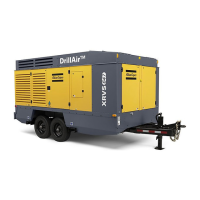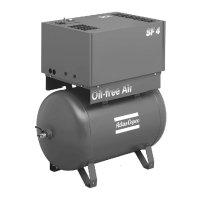46 2022 2096 26
High discharge temperature
Compressor valve assemblies defective
Discharge pressure too high
Inadequate ventilation or hot air recirculating
Cooling surfaces of compressor or intercooler excessively dirty
Ambient temperature too high
Scored or excessively worn cylinder walls
Head clearance insufficient
Piston loose in cylinder bore, cylinder bore worn, piston or piston rings worn
Worn rods or main bearing
Wrong pressure setting, discharge pressure excessive
Crankcase lubrication inadequate
Excessive oil consumption
Compressor runs unloaded too long
Compressor running too hot
Breather valve not functioning properly
Oil level in crankcase too high
Oil viscosity wrong for the application
Connecting rod out of alignment, bent or twisted
Piston rings not seated (allow 100 hours for seating)
Wrong oil (may be a detergent oil with a tendency to foam)
(To determine maximum
amperage allowed, multiply
the FLA on the motor
nameplate by the service
factor.)
Motor surface temperature
normally exceeds 170° F.
Low voltage (must be within 10% of nameplate voltage)
Loose electrical connection
Discharge pressure too high
Bearings tight or seizing
Overload relays are
designed to protect the
motor from damage due to
motor overload. If the
overload relay trips
persistently, DO NOT
CONTINUE TO PUSH THE
RESET BUTTON! Contact
your local Quincy
distributor for assistance.
Pressure switch incorrectly adjusted or faulty
